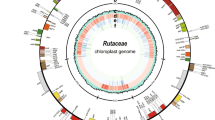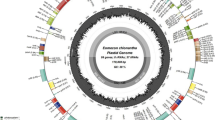Abstract
Cremanthodium Benth. is an endemic genus in the Himalayas and adjacent areas. Some plants of the genus are traditional medicinal plants in Tibetan medicine. In this study, the chloroplast genomes of five species (Cremanthodium arnicoides (DC. ex Royle) Good, Cremanthodium brunneopilosum S. W. Liu, Cremanthodium ellisii (Hook. f.) Kitam., Cremanthodium nervosum S. W. Liu, and Cremanthodium rhodocephalum Diels) were collected for sequencing. The sequencing results showed that the size of the chloroplast genome ranged from 150,985 to 151,284 bp and possessed a typical quadripartite structure containing one large single copy (LSC) region (83,326–83,369 bp), one small single copy (SSC) region (17,956–18,201 bp), and a pair of inverted repeats (IR) regions (24,830–24,855 bp) in C. arnicoides, C. brunneopilosum, C. ellisii, C. nervosum, and C. rhodocephalum. The chloroplast genomes encoded an equal number of genes, of which 88 were protein-coding genes, 37 were transfer ribonucleic acid genes, and eight were ribosomal ribonucleic acid genes, and were highly similar in overall size, genome structure, gene content, and order. In comparison with other species in the Asteraceae family, their chloroplast genomes share similarities but show some structural variations. There was no obvious expansion or contraction in the LSC, SSC or IR regions among the five species, indicating that the chloroplast gene structure of the genus was highly conserved. Collinearity analysis showed that there was no gene rearrangement. The results of the phylogenetic tree showed that the whole chloroplast genomes of the five species were closely related, and the plants of this genus were grouped into one large cluster with Ligularia Cass. and Farfugium Lindl.






Similar content being viewed by others
Data Availability
The data that support the findings of this study have been deposited in the NCBI database (GenBank accession: OM386855, OM386856, OM386857, OM386858, OM386859) (http://www.ncbi.nlm.nih.gov/).
References
Chen H, Zhu Y, Shen XM, Jia ZJ (1996) Four new sesquiterpene polyol esters from Cremanthodium ellisii. J Nat Prod 59:1117–1120. https://doi.org/10.1021/NP9601768
Chen XL, Zhou JG, Cui YX, Wang Y, Duan BZ, Yao H (2018) Identification of Ligularia herbs using the complete chloroplast genome as a super-barcode. Front Pharmacol 9:1–11. https://doi.org/10.3389/fphar.2018.00695
Flora Reipublicae Popularis Sinicae Editorial Board of the Chinese Academy of Sciences (1989) Flora reipublicae popularis sinicae, vol 7. Science Press, Beijing, p 115
Gichira AW, Avoga S, Li Z, Huang GW, Wang QF, Chen JM (2019) Comparative genomics of 11 complete chloroplast genomes of Senecioneae (Asteraceae) species DNA barcodes and phylogenetics. Bot Stud 60:1–17. https://doi.org/10.1186/s40529-019-0265-y
Gu Y, Ma Q, Lu Y (2016) Characterization of the complete chloroplast genome of Farfugium japonicum (Asteraceae). Mitochondrial DNA B 6:678–679. https://doi.org/10.1080/23802359.2021.1881928
He XY, Dong SJ, Gao CS (2022) The complete chloroplast genome of Carpesium abrotanoides L. (Asteraceae): structural organization, comparative analysis, mutational hotspots, and phylogenetic implications within the tribe Inuleae. Biologia 77:1861–1876. https://doi.org/10.1007/s11756-022-01038-2
Jin JJ, Yu WB, Yang JB, Song Y, dePamphilis CW, Yi TS, Li DZ (2020) GetOrganelle: a fast and versatile toolkit for accurate de novo assembly of organelle genomes. Genome Biol 21:241–272. https://doi.org/10.1186/s13059-020-02154-5
Kim KJ, Choi KS, Jansen RK (2005) Two chloroplast DNA inversions originated simultaneously during the early evolution of the sunflower family (Asteraceae). Mol Biol Evol 22:1783–1792. https://doi.org/10.1093/molbev/msi174
Kim JK, Park JY, Lee YS, Woo SM, Park HS, Lee TJ, Sung SH, Yang TJ (2016) The complete chloroplast genomes of two Taraxacum species, T. platycarpum Dahlst. and T. mongolicum Hand. –Mazz. (Asteraceae). Mitochondrial DNA B 1:412–413. https://doi.org/10.1080/23802359.2016.1176881
Kurtz S, Choudhuri JV, Ohlebusch E, Schleiermacher C, Stoye J, Giegerich R (2001) REPuter: the manifold applications of repeat analysis on a genomic scale. Nucleic Acids Res 29:4633–4642. https://doi.org/10.1093/nar/29.22.4633
Lee J, Lee H, Lee SC, Sung SH, Kang JH, Lee TJ, Yang T (2016) The complete chloroplast genome sequence of Ligularia fischeri (Ledeb.) Turcz. (Asteraceae). Mitochondrial DNA B 1:4–5. https://doi.org/10.1080/23802359.2015.1137793
Li H, Wang LJ, Qiu GF, Yu JQ, Liang SC, Hu XM (2007) Apoptosis of Hela cells induced by extract from Cremanthodium humile. Food Chem Toxicol 45:2040–2046. https://doi.org/10.1016/j.fct.2007.05.001
Liu JQ, Wang YJ, Wang AL, Hideaki O, Abbott RJ (2006) Radiation and diversification within the Ligularia–Cremanthodium–Parasenecio complex (Asteraceae) triggered by uplift of the Qinghai-Tibetan Plateau. Mol Phylogenet Evol 38:31–49. https://doi.org/10.1016/j.ympev.2005.09.010
Nordenstam B (2007) Tribe senecioneae cass. In: Kadereit JW, Jeffrey C (eds) The families and genera of vascular plants, flowering plants: eudicots, Asterales, vol 8. Springer, Berlin, pp 208–242
Nordenstam B, Pelser PB, Kadereit JW (2009) Senecioneae. In: Funk VA, Susanna A, Stussey TF et al (eds) Systematics, Evolution, and biogeography of compositae. International Association for Plant Taxonomy, Vienna, pp 503–525
Panero JL, Funk VA (2008) The value of sampling anomalous taxa in phylogenetic studies: major clades of the Asteraceae revealed. Mol Phyl Evol 47:757–782. https://doi.org/10.1016/j.ympev.2008.02.011
Saito Y, Ichihara M, Okamoto Y, Gong X, Kuroda C, Tori M (2012) Four new eremophilane-type alcohols from Cremanthodium helianthus collected in China. Nat Prod Commun 7:423–426. https://doi.org/10.1177/1934578x1200700402
Shi L, Chen H, Jiang M, Wang L, Wu X, Huang L, Liu C (2019) CPGAVAS2, an integrated plastome sequence annotator and analyzer. Nucleic Acids Res 7:65–73. https://doi.org/10.1093/nar/gkz345
Stamatakis A (2014) RAxML version 8: a tool for phylogenetic analysis and post-analysis of large phylogenies. Bioinformatics 30:1312–1313. https://doi.org/10.1093/bioinformatics/btu033
Su BN, Zhu QX, Jia ZJ (1999) A new nor-neolignan from Cramanthodium ellisii. Chin Chem Lett 10:129–130
Su BN, Zhu QX, Jia ZJ (2020) Nor-lignan and sesquiterpenes from Cremanthodium ellisii. Phytochemistry 53:1103–1108. https://doi.org/10.1016/S0031-9422(99)00584-1
Tori M, Saito Y, Takiguchi K, Gong X, Kuroda C (2012) Three new bisabolanetype sesquiterpenoids from Cremanthodium Rhodocephalum (Asteraceae). Heterocycles 86:497–503. https://doi.org/10.3987/COM-12-S(N)47
Tu YQ, Yang RP, Shou QY (2006) Study on volatile chemical constituents of Cremanthodium pleurocaulis. China J Chin Mater Med 6:522–524
Tyagi S, Jung JA, Kim JS, Won SY (2020a) A comparative analysis of the complete chloroplast genomes of three Chrysanthemum boreale strains. PeerJ 8:e9448. https://doi.org/10.7717/peerj.9448
Tyagi S, Jung JA, Kim JS, Won SY (2020b) Comparative analysis of the complete chloroplast genome of mainland Aster spathulifolius and Other aster species. Plants 9:568. https://doi.org/10.3390/plants9050568
Wang AX, Zhong Q, Jia ZJ (2004) Phenylpropanosids, lignans and other constituents from Cremanthodium ellisii. Pharmazie 59:889–892
Wang R, Liu JF, Liu SY, Guan SY, Jiao P (2020) Characterization of the complete chloroplast genome of Saussurea involuerata (Compositae), an endangered species endemic to China. Mitochondrial DNA B 5:511–512. https://doi.org/10.1080/23802359.2019.1705195
Wu QX, Zhu Y, Jia ZJ (2003) Study on volatile chemical constituents of Cremanthodium Discoideum. Lanzhou Daxue Xuebao, Ziran Kexueban 39:107–108. https://doi.org/10.13885/j.issn.0455-2059.2003.01.022
Yang L, Chen H, Jia ZJ (1995) Lignan and a Coumarin from Cremanthodium ellisii Kitam. Indian J Chem B: Org Chem Incl Med Chem 34:975–977
Zhu Y, Zhu QX, Jia ZJ (2000) Epoxide sesquiterpenes and steroids from Cremanthodium discoideum. Aust J Chem 53:831–834. https://doi.org/10.1071/ch00100
Zhu Y, Liang QW, Jia ZJ (2001) Sesquiterpenes and phenolic compounds from Cremanthodium Discoideum. Lanzhou Daxue Xuebao, Ziran Kexueban 37:68–75. https://doi.org/10.13885/j.issn.0455-2059.2001.04.015
Acknowledgements
We thank Prof. Xiang Liu and Prof. Huarong Zhou for their assistance during leaves collection.
Funding
This work was supported by National Key Research and Development Program of China (No. 2019YFC1712300) and Jiangxi University of Chinese Medicine Science and Technology Innovation Team Development Program (CXTD22002).
Author information
Authors and Affiliations
Contributions
WZ performed the experiments, data processing and manuscript draft preparation, XD contributed to analyzing the data, LC and ZM performed sample collection, XW and GZ designed the project and approved the final manuscript version.
Corresponding authors
Ethics declarations
Conflict of interest
The authors declare that they have no conflict of interest.
Additional information
Publisher's Note
Springer Nature remains neutral with regard to jurisdictional claims in published maps and institutional affiliations.
Rights and permissions
Springer Nature or its licensor (e.g. a society or other partner) holds exclusive rights to this article under a publishing agreement with the author(s) or other rightsholder(s); author self-archiving of the accepted manuscript version of this article is solely governed by the terms of such publishing agreement and applicable law.
About this article
Cite this article
Zhong, W., Du, X., Wang, X. et al. Comparative analyses of five complete chloroplast genomes from the endemic genus Cremanthodium (Asteraceae) in Himalayan and adjacent areas. Physiol Mol Biol Plants 29, 409–420 (2023). https://doi.org/10.1007/s12298-023-01292-x
Received:
Revised:
Accepted:
Published:
Issue Date:
DOI: https://doi.org/10.1007/s12298-023-01292-x




